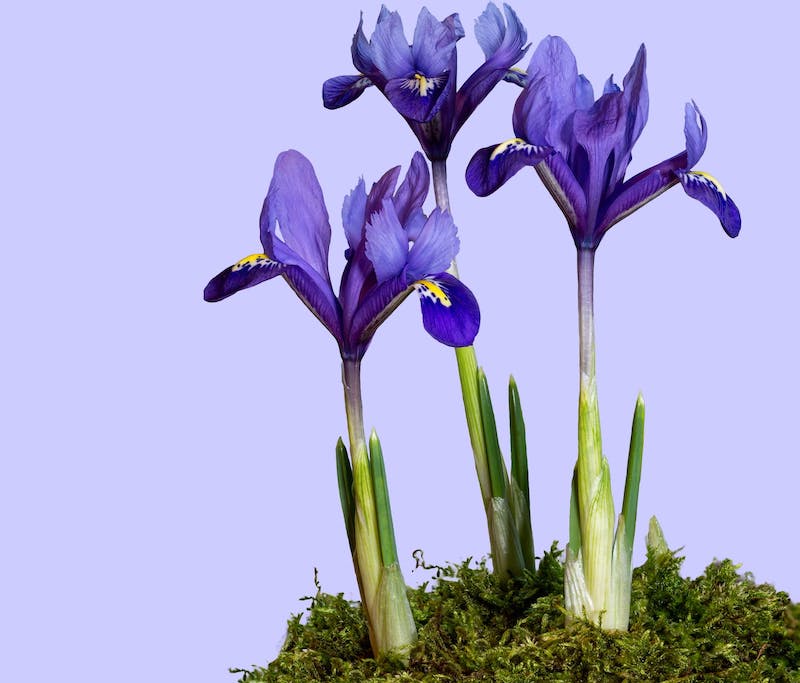Virtually all types of iris can be successfully grown in containers. The smaller bulbous Dutch hybrid cultivars require the least amount of maintenance and are easily added to mixed seasonal containers. With the right sized pot and extra support from stakes, bearded iris and Siberian iris provide great color on a deck or patio; pot them as a single specimen in a modern container for a beautiful statement.

Planting Iris in Pots
The best time of year to plant iris in pots depends on the type of roots your plant has. Bulbous types bloom from late February until June in most growing zones. These irises require a period of chilling before blooming and need to be planted anytime from late September to November. The much larger bearded, Siberian, and Japanese irises all bloom from late spring to early fall and can be planted at any time of the year, although spring is when they are most often available in nurseries.
All types of iris require well-draining potting mix and containers. Mix three parts peat-free potting soil with one-part perlite for a wonderful DIY potting mix. Bulb types of iris need to be planted twice as deep as they are large. They also can be layered with other spring bulbs to extend the season of color. Irises with fleshy rhizomes will need a pot with at least a 2-gallon capacity and preferably wider than taller to compensate for a top-heavy plant in full bloom. Place the rhizome slightly proud of the soil just as you would when planting the Iris in the ground and place the pot in full sun. Fibrous rooted Irises will also benefit from a wide pot. Ensure that the base of the leaves is just at the soil level when planting.
Best Soil For Iris in Pots
An all-purpose, peat-free potting mix works well for all irises. Do not add a layer of pea gravel or drainage rock to the bottom of pots with the idea that the drainage would be improved. The reality is the opposite. Layers of material to ”improve” drainage form a perched water table that impedes the growth of the plant's root system and can even prevent roots from accessing water properly. If you are worried about soil being washed out of the bottom drainage holes, a paper coffee filter or a piece of fine mesh (from a window screen or hardware cloth) can be placed over the holes inside the pot before adding the potting mix.
Caring For Iris in Planters
Iris growing in containers are reliant on the gardener to supply water, nutrients, and sun exposure. Fortunately, irises are very hardy and adaptable plants that will thrive in a container for many years. Read on to learn about how to water, feed, and winterize your pots for growing success year after year.
Watering Iris in Pots
Irises grow best in soil that has excellent drainage and aeration. Allow the top 2-3 inches of potting soil to dry in between waterings. Larger planters will retain moisture longer than small pots. Check your containers daily until you are familiar with how fast they dry out. Supplemental watering may be needed during the hottest parts of the summer and as the plant's root system grows larger. Ensure that all of the soil in the pot is saturated by watering until liquid runs from the bottom drainage holes.
Fertilizing Iris in Pots
Iris will require regular fertilizing when growing in a planter. Frequent watering will leach nutrients from the potting mix. Use a diluted liquid fertilizer when new growth starts early in the spring and then again after flowering has ended. Look for formulations that have a lower N (nitrogen) number. High nitrogen fertilizers will encourage heavy foliage growth, making the plant much more susceptible to pests such as iris borers and aphids. Fertilizers labeled for tomatoes and roses or blooming plants will support good root systems and flowering.
Winter Care For Iris in Pots
Iris in containers may need extra protection from extended periods below 25 degrees Fahrenheit. Move pots to a sheltered location out of the path of prevailing winds and storms if you live in growing zones 5-8. Potted irises in colder zones may need to be sunk in the garden or moved to a spot in an unheated garage to provide insulation for the rhizomes. This is an easy technique for smaller, non-decorative containers, but large planters can be wrapped in layers of burlap or horticultural fabric for winter protection.

Growing Iris Indoors
Dutch hybrid iris bulbs can be forced for display indoors at the end of winter. Because they need a period of chilling to bloom well, the pots are best left in an unheated garage or greenhouse until they begin to show green growth late in the winter. Begin watering irises when the foliage is 2-3 inches tall. This is also the time to bring plants inside to force them to bloom earlier. Place the pots in a bright spot out of direct sunlight and water when the top 1-2 inches of potting soil are dry.
 |
Author Robbin Small - Published 4-18-2023 |
